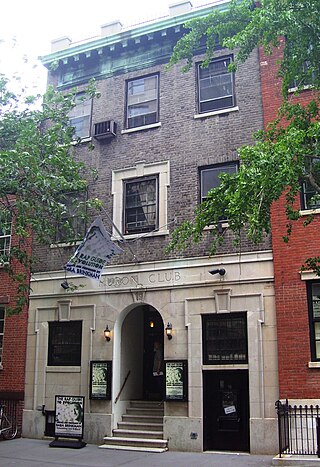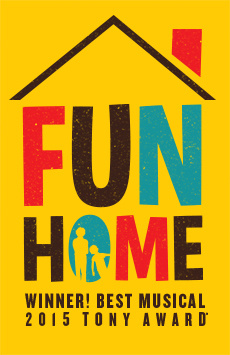Related Research Articles

Edward Franklin Albee III was an American playwright known for works such as The Zoo Story (1958), The Sandbox (1959), Who's Afraid of Virginia Woolf? (1962), A Delicate Balance (1966), and Three Tall Women (1994). Some critics have argued that some of his work constitutes an American variant of what Martin Esslin identified and named the Theater of the Absurd. Three of his plays won the Pulitzer Prize for Drama and two of his other works won the Tony Award for Best Play.

Who's Afraid of Virginia Woolf? is a play by Edward Albee first staged in October 1962. It examines the complexities of the marriage of middle-aged couple Martha and George. Late one evening, after a university faculty party, they receive unwitting younger couple Nick and Honey as guests, and draw them into their bitter and frustrated relationship.
Three Tall Women is a two-act play by Edward Albee that premiered at Vienna's English Theatre in 1991. The three unnamed women, one in her 90s, one in her 50s, and one in her 20s, are referred to in the script as A, B, and C. The character of A, the oldest woman, is based in part on Albee's mother. In the first act, B is the caretaker and C is the lawyer for A, while in the second act they become personifications of A from earlier in her life.

Lucille Lortel was an American actress, artistic director, and theatrical producer. In the course of her career Lortel produced or co-produced nearly 500 plays, five of which were nominated for Tony Awards: As Is by William M. Hoffman, Angels Fall by Lanford Wilson, Blood Knot by Athol Fugard, Mbongeni Ngema's Sarafina!, and A Walk in the Woods by Lee Blessing. She also produced Marc Blitzstein's adaptation of Bertolt Brecht and Kurt Weill's Threepenny Opera, a production which ran for seven years and according to The New York Times "caused such a sensation that it...put Off-Broadway on the map."
The American Dream is an early, one-act play by American playwright Edward Albee. It premiered in 1961.

The Zoo Story is a one-act play by American playwright Edward Albee. His first play, it was written in 1958 and completed in just three weeks. The play explores themes of isolation, loneliness, miscommunication as anathematization, social disparity and dehumanization in a materialistic world. Today, professional theatre companies can produce The Zoo Story either as a part of Edward Albee's at Home at the Zoo, or as a standalone play. Its prequel, Homelife, written in 2007, however, can only be produced as a part of Edward Albee's at Home at the Zoo.

The Lady from Dubuque is a play by Edward Albee, which premiered on Broadway in 1980 for a brief run. The play ran in London in 2007.

The Beauty Queen of Leenane is a 1996 dramatic play by Martin McDonagh which was premiered by the Druid Theatre Company in Galway, Ireland. It also enjoyed successful runs at London's West End, Broadway and Off-Broadway.
Marriage Play is a drama for two actors by Edward Albee. The play premiered at Vienna's English Theatre in 1987.
The Death of Bessie Smith is a one-act play by American playwright Edward Albee, written in 1959 and premiered in West Berlin the following year. The play consists of a series of conversations between Bernie and his friend Jack, Jack and an off-stage Bessie, and black and white staff of a whites-only hospital in Memphis, Tennessee on the death date of the famous blues singer, Bessie Smith, who died in a car wreck.

The Play About the Baby is a play by Edward Albee.
Tiny Alice is a three-act play written by Edward Albee that premiered on Broadway at the Billy Rose Theatre in 1964.
Myra Carter was an American stage, screen and television actress.
Edward Albee's At Home at the Zoo is a play by Edward Albee which adds a first act to his 1959 play The Zoo Story. This first act, also called Homelife, revolves around the marriage of Peter and Ann and ends with Peter leaving to go read a book in Central Park.

The SoHo Playhouse is an Off-Broadway theatre at 15 Vandam Street in the Hudson Square area of Manhattan.
Finding the Sun is a one-act play by American playwright Edward Albee.
Pam MacKinnon is an American theatre director. She has directed for the stage Off-Broadway, on Broadway and in regional theatre. She won the Obie Award for Directing and received a Tony Award nomination, Best Director, for her work on Clybourne Park. In 2013 she received the Tony Award for Best Direction of a Play for a revival of Who's Afraid of Virginia Woolf? She was named artistic director of American Conservatory Theater in San Francisco, California on January 23, 2018.

Jennifer von Mayrhauser is an American costume designer who has designed costumes for more than thirty Broadway productions, and is notable for her significant contributions in film, television, and theatre.

Fun Home is a musical theatre adaptation of Alison Bechdel's 2006 graphic memoir of the same name, with music by Jeanine Tesori, and book and lyrics by Lisa Kron. The story concerns Bechdel's discovery of her own lesbian sexuality, her relationship with her closeted gay father, and her attempts to unlock the mysteries surrounding his life. It is told in a series of non-linear vignettes connected by narration provided by the adult Alison character.
Me, Myself and I is a 2007 play by Edward Albee. It is an absurdist family comedy/drama.
References
- Albee, Edward. 'The American Dream and The Zoo Story: Two Plays by Edward Albee. New York: Plume,.